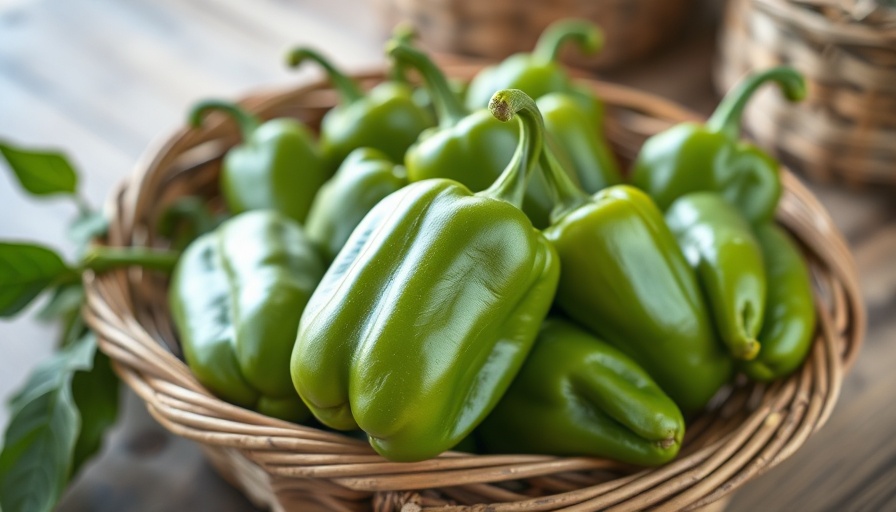
Discover the Rich Flavor of Hatch Peppers
If you’ve ever marveled at the vibrant hues of Southwestern cuisine, then Hatch peppers are likely familiar to you. Renowned for their smoky, earthy flavor, these peppers thrive in the unique climate of the Hatch Valley in New Mexico. As enthusiasts of sustainable living and home gardening, learning how to cultivate these delightful peppers can introduce a new world of flavors to your meals while also providing the joy of nurturing your own garden.
Why Grow Your Own Hatch Peppers?
Growing your own Hatch peppers allows you to curate the perfect growing conditions, resulting in a flavor profile you may not find in store-bought varieties. Home gardening not only empowers you to choose organic practices but also connects you with nature and your community. Plus, fresh produce straight from your garden can inspire you to create delicious, health-conscious meals that are bursting with flavor.
Growing Conditions and Best Practices
Hatch peppers require a specific set of conditions to flourish:
- Climate: These peppers prefer hot days and cool nights, with a need for full sun exposure.
- Soil: Use organically-rich loam with good drainage, adjusted to a pH of 6.0-7.0 for the best growth.
- Water: Maintain consistent, moderate watering, ensuring that the soil remains moist but not waterlogged.
As a short-lived perennial, Hatch peppers can be grown effectively in USDA Zones 9-11. With a time to maturity between 75-90 days, cultivators can enjoy a bountiful harvest within a growing season!
Choosing Your Cultivar Wisely
When selecting your Hatch pepper seeds, it's essential to recognize the diverse cultivars available. Ranging from mild to extra hot, there is a Heat Level throughout the New Mexico cultivar group. Remember that while you can grow similar peppers elsewhere, true “Hatch” peppers come from the Hatch Valley, which means your homegrown version will carry your unique touch!
Protecting Your Crop from Pests
One of the larger challenges that face home gardeners is managing pests. To ensure a successful harvest of Hatch peppers, consider integrating pest-resistant plants into your garden layout. Companion planting not only helps safeguard your peppers but also enhances the overall ecosystem of your garden. Useful companions include marigolds, which deter harmful insects, and basil, known for both its protective qualities and delicious flavor in your cooking.
Harvesting Techniques
Once your Hatch peppers are ready to harvest, the process can be as enjoyable as the growing phase. For optimal flavor, pick the peppers when they are firm, shiny, and have reached full color. Tools such as sharp garden shears can prevent damaging the plants, ensuring continued growth throughout the season.
Preserving Your Bounty
After harvest, it's time to consider preservation methods. Roasting your Hatch peppers enhances their flavor, and they can be frozen or canned for use later in soups, stews, or salsas.
Learning beneficial seed starting techniques or exploring DIY gardening projects can enhance your gardening skills further. Prepare to embark on a journey of self-sufficiency and share your freshly grown produce with friends and neighbors, fostering community connections.
Cooking Ideas to Inspire
Finally, the true joy of gardening often comes from creating delightful dishes with your harvest. Hatch peppers can be introduced into various dishes, from blending them into salsas to stuffing them with cheese and spices for a flavorful appetizer. Let your culinary creativity flow!
Step into Your Gardening Journey!
Now that you have a robust understanding of how to grow Hatch peppers, embark on your gardening adventure! Embrace the challenge and enjoy the process of nurturing these unique chiles in your back garden. Whether sharing with friends or cooking up new recipes, the flavors of Hatch peppers will surely enrich your cooking experience.
As you plan and execute your gardening strategy, keep in mind that cultivating your own food not only satiates your culinary cravings but strengthens your commitment to eco-friendly living.
 Add Row
Add Row  Add
Add 




 Add Row
Add Row  Add
Add 

Write A Comment